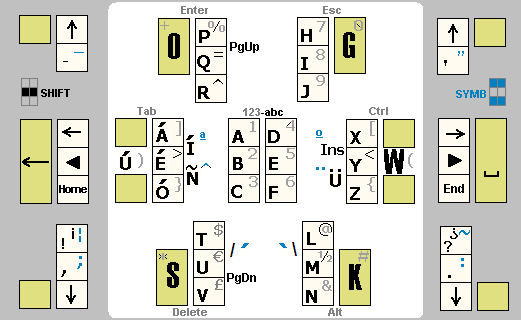
Native GKOS Character Sets
The
national/native GKOS
character sets should be phonetically mapped to the basic Latin
alphabet layout as much as possible. This makes it easy to switch
between languages
using the typing skill effectively. If the national characters have no
resemblance to the Latin alphabet, a different layout can be used
(Thai,
Chinese...). It is also possible to define word shortcuts.
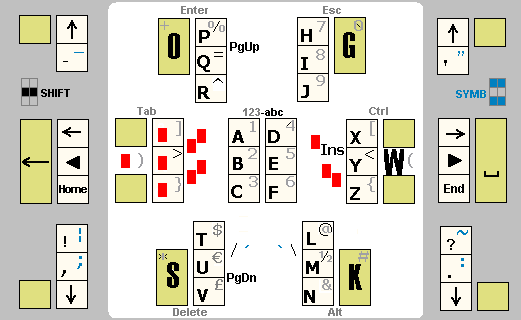
This figure shows in red color which parts of the GKOS keyboard layout should be modified, if necessary, to obtain a native layout version. Note that in the Tab group, there are 6 characters that can be typed by just one depression of a chord (no shift needed). If possible, the 4-key chords of the Tab group should be used for special symbols. In some native layouts, the characters in the Tab group could be used as modifiers (shifts) to get 6 more sets of letters/characters. For example, the Polish set can be similar to the Finnish or English sets (exept for the native part) and the many types of diacritics can be added to letters by a single preceding modifier (e.g. the combo corresponding to "to " of the English set in the Tab group.
In some languages, common words may
be more
frequent than certain letters (e.g. 'the' versus 'x'). Please see the
English layout below as an example of using the native characters
as whole common words.
As examples of more changes, here are the 'official' Greek, Korean and Russian GKOS layout proposals.
Greek GKOS layout:
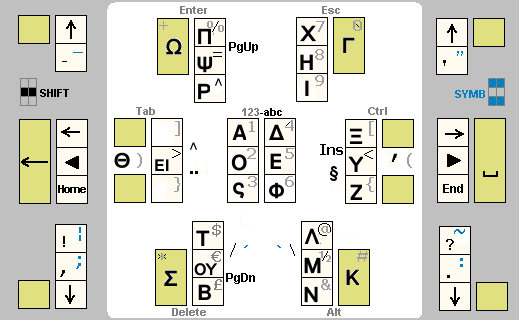
The Greek character set has been designed with the common GKOS goal in mind that native versions should be compatible phonetically with each other as much as possible. This way the typing skill obtained can be used effectively when switching between layouts. As letters C and W do not exist in Greek, and B (as in 'best', typed 'μ' followed by 'π') is somewhat rare in Greek, Keys [B] and [C] are used for letters o-micron and ι that are frequent in Greek. Now, o-micron (O/ο) and o-mega (Ω/ω) reside partly in the same Keys (in a logical way); so do also sigma (Σ/σ), word-final sigma (ς) and Z/ζ. Acute accent is very common and it has been assigned the 'light-weight' Combo [W].
Note:
Letters in Modern Greek in an approximate order of frequency:
οαιρτσςμνευλπηκγχφδωθβξζψ
Korean GKOS layout (revised Feb 2011):
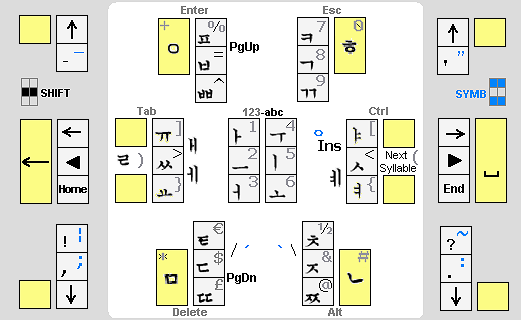
The Korean
Hangul set was modified in Feb 2011
after testing it on an Android touch screen application (not availabe
yet on Jan 15, 2011). It was noted that the G, K, O, S and TH Modifier
Combos served best as the most common consonants.
The Korean alphabet lends itself pretty well to the GKOS keyboard. The
six keys by themselves give the six basic vowels ah, oe, o, u, eu and
ee. You simply iotize vowels ah, oe, o, and u into ya, yoe, yo and yu
by using Modifiers TH and W. Typing the standard diphthongs also turns
out to be quick and easy. (Symbols on keys D (4) and F (6) were swapped
in order to eliminate accidental Up/Down Arrows while typing diphthongs
carelessly.)
By using the G, K, O, S and TH modifiers as the most common consonants,
the typing becomes fluent as most of the frequently used symbols are
directly visible. The four letters gieuk, dieut, bieup and jieut along
with their associated aspirated and glottalized letters (4 x 3 in
total) are assigned under the four main Modifier positions. The
remaining letters and the most common diphtongs are assigned to the
remaining Combos.
The round null letter ieung (o) and the round (h) sit in same positions
as latin O and 0 (zero). A natural Chordon stroke (W) allows for the
'Next Syllable' Combo if needed.
The placement of the letters in the syllable block will be taken care
of by the application (on a PC or smartphone). There are exactly 29
characters in Hangul. These along with the Next Syllable keystroke fill
all the available key Combos in a very rational manner.
This was the original plan (a great starting point!):
The
Korean
alphabet lends itself
pretty well to the GKOS keyboard. The six keys by themselves give
the six basic
vowels ah, oe, o, u, eu and ee. By using the G, K, O and S
shifts, you
get the iotized vowels, ya, yoe, yo and yu. Typing the standard
diphthongs turns out to be very easy.
The
four
letters gieuk, dieut, bieup and jieut are assigned to the
shifted positions along with their associated aspirated and
glottalized letters, The remaining letters are assigned to the
remaining key combinations. The null letter ieung (o) sits in a
position that allows for a natural Chordon stroke with the Next
Syllable key. It is easy to extend the set by using SHIFT (a native
Korean proposal is welcomed!).
The placement of the letters in the syllalble block will be taken care of by the PC. There are exactly 29 characters in Hangeul. These along with the Next Syllable keystroke fill all the available key combos. (Many thanks to Robb Bates for drafting this layout!)
The middle vowels/diphtongs consisting of 2...3 'basic vowels' (directly visible above) can also be quickly typed as Chordons. For example, a diphtong, in the middle of a syllable, consisting of vowels on keys 4, 1 and 2 is typed by pressing down keys 4 and 1 first, then adding key 2, and then of course releasing all three (not implemented in the typing demo yet).
Text messaging in Korean is already easy on the 12-key keypad of cell phones thanks to the clever design and the small number of letters required. So, what is gained by GKOS? - Well, you only need 6 keys and have quick access to all special characters, as well as all the special keys and functions found on a PC qwerty keyboard. GKOS also has more Korean characters than the standard SMS pad (directly 29 characters instead of 24, and then all combined vowels/diphtongs)... plus the 35 general GKOS advantages...
Russian GKOS Layout:
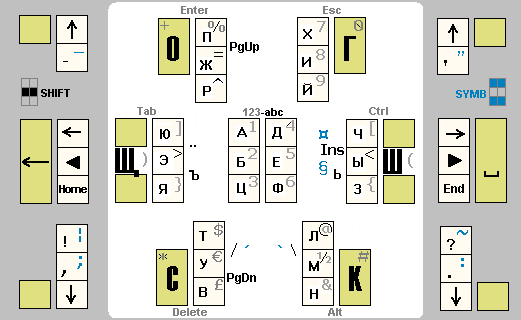
The Russian layout
is phonetically mapped to
the basic Latin set,
so you can type e.g. names the same way (using the same combos/chords)
as with the latin GKOS layout and a native russian can read it in
cyrillic letters and get the idea more or less correctly. In fact, you
can immediately type with Russian letters a lot if you are used to the
Latin (English/Swedish/Finnish/German...) layout!
The Russian set can be used for Ukranian as well, providing that a preceding ¨ ('double dots' or diaeresis/umlaut modifier of Tab group) turnes Г and г into Ґ and ґ (and also І, і into Ї, ї).
Alphabets based on the Russian alphabet and having several additional letters, like Kazakh, can be implemented by using the 'double dots' of Tab group as a more general modifier (e.g. E => Ë, У => Ұ, Н => Ң etc.) .
Less Radical Changes below
German Layout:

Finnish/Swedish Layout:
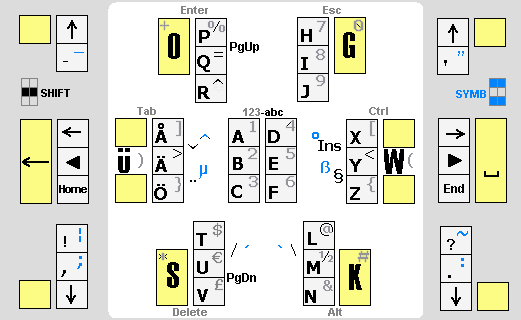

Icelandic layout:
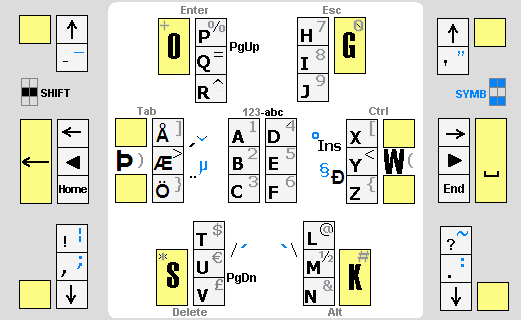
French layout:

Spanish layout:
Sanskrit GKOS typing -
something different:
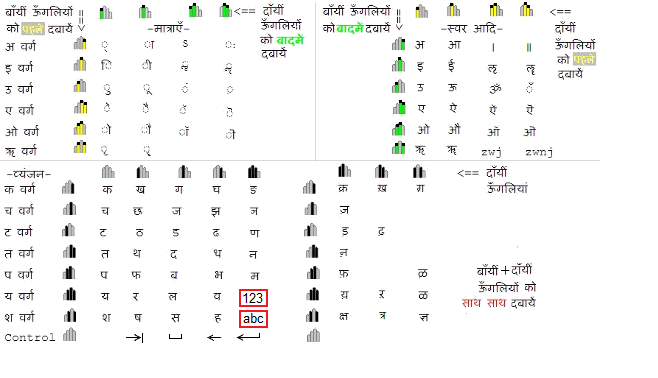
Sanskrit vowels are in two groups above: those to combine with consonants and those independently typed. Vowels of the first group are typed by pressing the left hand keys first (yellow), and the second group vice versa (but yellow first as well). Consonants are typed by pressing the keys at the same time. It is possible to switch to the 'standard' GKOS numbers mode (123) and to the English GKOS layout (abc), then back from English by [Alt] [123abc])
...and as a reference, the English layout:
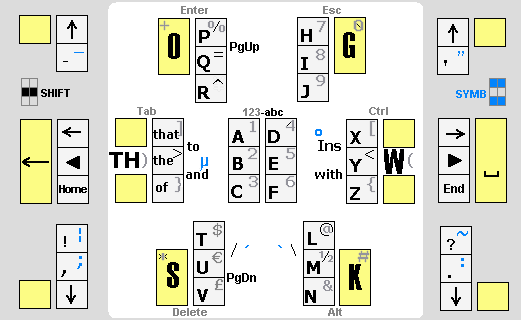
In case you are a Linux user, you can test many of these layouts right away:
- See http://gkos.com/linux
- Or, you can try GKOS typing with your browser in 2 seconds from now (Windows users as well)!
Page updated (Korean modifies) 15 Feb 2011
